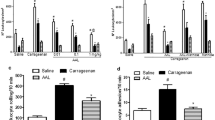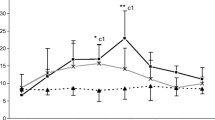Abstract
The anti-inflammatory effects of the non-steroidal anti-inflammatory drugs phenylbutazone (PBZ) and flunixin meglumine (FM) and the relationship between the effects and drug concentration in vivo were studied using a subcutaneous tissue-cage model in sheep. Intracaveal injection of carrageenan induced prostaglandin (PG) E2production in tissue-cage exudate (maximal concentration, 101 nM) with significant increases in white blood cell (WBC) numbers, skin temperature over the inflamed cage and exudate leukotriene B4 (LTB4) concentration (P < 0.05). Intravenous PBZ, 4.4 mg kg−1 produced mild inhibition of exudate PGE2 generation (10%), but greater inhibition of serum TXB2 (75.3%). The IC50 for TXB2 was 36.0 μM. Phenylbutazone did not alter effects on skin temperature, WBC numbers or exudate LTB4 concentrations. Intravenous FM, 1.1 mg kg−1, significantly inhibited carrageenan-induced exudate PGE2 formation (Emax, 100%, IC50, <0.4 nM) and serum TXB2 generation (Emax, 100%, IC50, 17 nM) for up to 32 h. Flunixin meglumine significantly inhibited the rise in skin temperature but had a limited effect on exudate WBC. Phenylbutazone and FM have distinct effects on carrageenan-induced cyclooxygenase (COX-2) and platelet COX (COX-1). Flunixin meglumine was a more potent COX inhibitor than PBZ and was more selective for the inducible form of COX in vivo.
Similar content being viewed by others
REFERENCES
Zederfeldt, B., I. Borg, and K. Haeger. 1977. Efficacy and tolerance of flunixin (SCH-14741) in the treatment of postoperative pain, with observations on the methodology of postoperative pain studies. Br. J. Anaesth., 49, 467–471.
Ciofalo, V. B., M. B. Latranyi, J. B. Patel, and R. I. Taber. 1977. Flunixin meglumine: a non-narcotic analgesic. J. Pharmacol. Exp. Ther., 200, 501–507.
McKellar, Q. A., E. A. Galbrath, J. A. Bogan, C. S. Russell, R. E. Hooke, and P. Lees. 1989. Flunixin pharmacokinetics and serum thromboxane inhibition in the dog. Vet. Rec., 124, 651–654.
Lees, P. and A. J. Higgins, 1984. Flunixin inhibits prostaglandin E2 in equine inflammation. Res. Vet. Sci., 37, 374–349.
Landoni, M. F., F. M. Cunningham, and P. Lees. 1995. Determination of pharmacokinetics and pharmacodynamics of flunixin in calves by use of pharmacokinetic/pharmacodynamic modelling. Vet. Rec., 56, 786–794.
Vane, J. R. 1971. Inhibition of prostaglandin synthesis as a mechanism of action for aspirin-like drugs. Nature New Biol. 231, 232–239.
Ouderaa, F. J.,Buytenhek, M., Van Der, D. H. Nugteren, and Van D. A. Dorp, 1977. Purification and characterisation of prostaglandin endoperoxide synthetase from sheep vesicular glands. Biochim. Biophys. Acta, 478, 315–331.
Johnson, J. L., S. D. Wimsatt, R. D. Dyer, and K. R. Maddipati. 1995. Purification and characterisation of prostaglandin H synthase-2 from sheep placental cotyledons. Arch. Biochem. Biophys., 324, 26–34.
Smith, W. L., and L. J. Marnett. 1991. Prostaglandin endoperoxide synthase: structure and catalysis. Biochim. Biophys. Acta, 1083, 1–17.
Higgins, A. J., P. Lees, and A. D. Sedgwick. 1987. Development of equine models of inflammation. Vet. Rec., 120, 517–522.
McKellar, Q. A., P. Lees, and G. Gettinby. 1994b. Pharmacodynamics of tolfenamic acid in dogs. Evaluation of dose response relationships. Eur. J. Pharmacol., 253, 191–200.
Higgins, A. J. and P. Lees, 1984. Arachidonic acid metabolites in carrageenan-induced equine inflammatory exudate. J. Vet. Pharmacol. Ther., 7, 65–72.
Higgins, A. J., P. Lees, and G. A. Higgs, 1984. Detection of prostaglandin-like activity in equine inflammatory exudate—A preliminary report. Equine Vet. J., 16, 71–72.
Higgs, G. A., E. A. Harvey, S. H. Ferrira, and J. R. Vane. 1976. In: Advances in Prostaglandin and Thromboxane Research, Eds B. Samuelsson & R. Paoletti. Volume 1, pp. 105–110. Raven Press, New York.
McKellar, Q. A., P. Delatour, and P. Lees. 1994a. Stereospecific pharmacodynamics and pharmacokinetics of carprofen in the dog. J. Vet. Pharmacol. Ther., 17, 447–454.
Cheng, Z., Q. McKellar, A. Nolan, and P. Lees, 1996. Pharmacokinetic and pharmacodynamic studies on phenylbutazone and oxyphenbutazone in donkeys. J. Vet. Pharmacol. Ther., 19, 149–151.
Kujubu, D. A., B. S. Fletcher, B. C. Varnuk, R. W. Lim, and H. R. Herschman. 1991. TIS10, a phorbol ester tumour promoter-inducible mRNA from Swiss 3T3 cells, encodes a novel prostaglandin synthase/cyclooxygenase. J. Biol. Chem., 266, 12866–12872.
Xie, W., W. J. Chipman, D. L. Robertson, R. L. Erikson, and D. L. Simmons. 1991. Expression of a mitogen-responsive gene encoding prostaglandin synthase is regulated by mRNA splicing. Proc. Natl. Acad. Sci. U.S.A., 88, 2692–2696.
O'Banion, M. K., V. D. Winn, and D. A. Young. 1992. cDNA cloning and functional activity of a glucocorticoid-regulated inflammatory cyclooxygenase. Proc. Natl. Acad. Sci. U.S.A., 89, 4888–4892.
Sirois, J., Simmons, D. L. and J. S. Richards. 1992. Hormonal regulation of messenger ribonucleic acid encoding a novel isoform of prostaglandin endoperoxide H synthase in rat preovulatory follicles. J. Biol. Chem., 267, 11586–11592.
DeWitt, D. L. and E. A. Meade, 1993. Serum and glucorticoid regulation of gene transcription and expression of the prostaglandin H synthease-1 and prostaglandin H synthase-2 isozyme. Arch. Biochem. Biophys., 306:94–102.
Jones, D. A., D. P. Carlton, T. M. McIntyre, G. A. Zimmerman, and S. M. Prescott. 1993. Molecular cloning of human prostaglandin endoperoxide synthase type II and demonstration of expression in response to cytokines. J. Biol. Chem., 268, 9049–9054.
Herschman, H. R. 1994. Regulation of prostaglandin synthase-1 and prostaglandin synthase-2 Cancer Metastasis Rev., 13, 241–256.
Laneuville, O., D. K. Breuer, D. L. DeWitt, T. Hla, D. C. Funk, and W. L. Smith. 1994. Differential inhibition of human prostaglandin endoperoxide H synthases-1 and-2 by nonsteroidal anti-inflammatory drugs. J. Pharmacol. Exp. Ther., 271, 927–934.
Smith, W. L., E. D. Meade, and D. L. DeWitt. 1994. Interactions of PGH synthase isozymes-1 and-2 with NSAIDs. Ann. N.Y. Acad. Sci., 744, 50–57.
Masferrer, J. L., B. S. Zweifel, P. T. Manning, S. D. Hauser, K. M. Leahy, W. G. Smith, P. C. Isakson, and K. Seibert. 1994. Selective inhibition of inducible cyclooxygenase-2 in vivo is antiinflammatory and nonulcerogenic. Proc. Natl. Acad. Sci. U.S.A., 91, 3228–3232.
Funk, C., L. B. Funk, M. E. Kennedy, A. S. Pong, and G. A. Fitzgerald. 1991. Human platelet/erythroleukemia cell prostaglandin G/H synthase: cDNA cloning, expression, and gene chromosomal assignment. FASEB J., 5, 2304–2311.
Kitchen, E. A., W. Dawson, K. D. Rainsford, and T. Cawston. 1985. Inflammation and possible modes of action of anti-inflammatory drugs. In: Antiinflammatory and Anti-rheumatic Drugs. ed. Rainsford, K. D. pp. 54–68. CRC Press, Boca Raton, Florida.
Lees, P., Q. A. McKellar, S. A. May, and B. Ludwig. 1993. Pharmacodynamics and pharmacokinetics of carprofen in horse. Equine Vet. J., 26:203–208.
Higgs, G. A., K. E. Eakins, K. G. Mugridge, S. Moncada, and J. R. Vane. 1980. The effects of non-steroidal anti-inflammatory drugs on leukocyte migration in carrageenin-induced inflammation. Eur. J. Pharmacol., 66, 81–86.
Lees, P., A. J. Higgins, A. D. Sedgwick, and S. A. May. 1987. Applications of equine models of acute inflammation. Vet. Rec., 120, 522–529.
Riendeau, D., S. Charleson, W. Cromlish, J. A. Mancini, E. Wong, and J. Guay. 1997. Comparison of the cyclooxygenase-1 inhibitory properties of nonsteroidal anti-inflammatory drugs (NSAIDs) and selective COX-2 inhibitors, using sensitive microsomal and platelet assays. Can. J. Physiol. Pharmacol. 75, 1088–1095.
Kankaanranta, H., E. Moilanen, and H. Vapaatalo. 1993. Comparison of in vitro effects of flunixin and tolfenamic acid on human leucocyte and platelet functions. Inflammation 17, 417–425.
Ford-Hutchinson, A. W., M. A. Bray, M. V. Doig, M. E. Shipley, and M. J. H. Smith. 1980. Leukotriene B4, a potent chemokinetic and aggregating substance released from polymorphonuclear leukocytes. Nature 286, 264–265.
Author information
Authors and Affiliations
Rights and permissions
About this article
Cite this article
Cheng, Z., Nolan, A.M. & McKellar, Q.A. Measurement of Cyclooxygenase Inhibition in vivo: A Study of Two Non-Steroidal Anti-Inflammatory Drugs in Sheep. Inflammation 22, 353–366 (1998). https://doi.org/10.1023/A:1022364731126
Issue Date:
DOI: https://doi.org/10.1023/A:1022364731126




